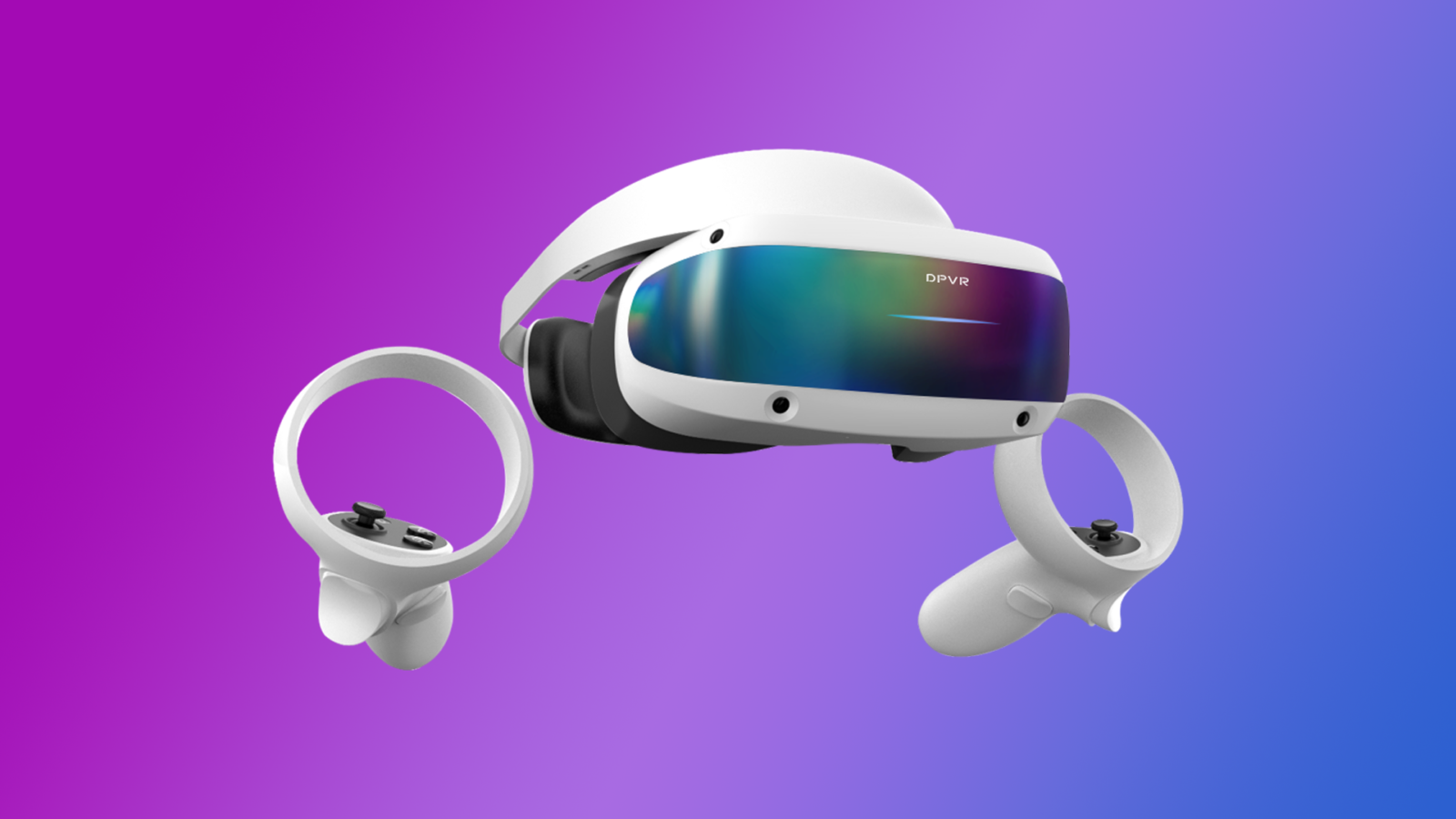The team at DPVR had a vision with the E4 which was to make an affordable PCVR headset, that is made to take full advantage of the power of a PC being behind it. I have now been running the hardware through lots of testing over the the past week. The question is have they met their goal?
WHAT'S IN THE BOX
Inside of the box you will get DPVR E4 headset, two controllers, a Display port 1.4 cable, the power adapter, two wrist straps and your user manual and guarantee.
SET-UP
One thing I was really impressed with was the ease of the set-up and the time taken from starting to actually being in your first VR game. This process is certainly made easier by the inside-out-tracking meaning no base station set-up is required.
You can download a tool from DPVR’s website before ordering that will let you know if your PC is up to running the hardware. Which is really handy and also runs as you open the software you need to run the headset on your PC.
This software you need to use to install and run it on your PC is DPVR Assistant 4. From here just run the through the steps of the installer which will take you through the features of the headset, connecting the cabels via the breakout box, pairing the controllers and creating your playspace. Which over all took me around fifteen-minutes max and I was ready to go.
Once this is all installed, you can click the Steam icon in the top corner of the DPVR Assistant and it will boot Steam VR for you, and there you go you are inside your Steam Home and ready to launch your first game with the headset.
Please note: If this is your first VR headset, you will need to install Steam VR from within your Steam client – which can be done before running through the DPVR Assistant steps.
HEAD MOUNTED DISPLAY (HMD)
For my testing over the week I wanted to into as many types of games as possible to get the best feel of what the headset offers. The seen me going into popular games like Half-Life: Alyx, Beat Saber, older games like Robinson: The Journey, visual novels, shooters and experiences like Gloomy Eyes.
QUALITY/COMFORT
One thing that really surprised me when taking the HMD out of the box was how light the headset was compare to others on the market, and even when connecting the cable to the breakout box on the wire coming from the HMD, it still kept the light-weight compared to the HTC Vive models, Index and Meta Quest 2. Now, with it being light-weight I thought they must have cut corners in quality to make it so light, but the HMD build is very sturdy and doesn’t feel cheap.
For the headstrap they have gone with a halo-strap, which does seem to be becoming the norm with most headsets releasing now. With the weight of the HMD the headset feels very comfortable with the halo-strap and they provide a rubber support across the top to offer that little bit more support and make it as comfortable as possible.

The facial interface is soft rubber in the ilk of PSVR and PSVR2, so its doesn’t fall solid against your face, and if done right this can feel great and be comfortable without having something more solid pressing against your face. With the rubber design being able to mold around your face easier it also makes sure there is no light leakage when using the HMD, which for me is very important while playing Virtual Reality.
Something that the team at DPVR have added to the E4 that I have not seen for a while is a flip up hinged design. Meaning if you want to look into the real world for any reason you can just flip up the HMD and you can see everything around you – which I was glad to see them include as although it offers pass through it’s not to the level you have become used to by 2023. Another little issue I found with the flip up display and the rubber facial interface it doesn’t always go back correctly when putting it back down. However, after doing this a number of times you soon learn how to get it back down without needing to adjust it afterwards.
The final little touch that seems to be removed as a normal feature on newer headsets that the E4 has in place is a clip on the back of the headstrap that runs the cable through it. With them also adding a clip to the cable, meaning you attach this to your clothes and keep the cable running securely down your back – at first I wasn’t sure what the benefit of this would be, but I use it every time now.
VISUALS
As I mentioned DPVR’s vision was bring an affordable headset made that will make full use of a PC being behind it, and they have done this by using a Display Port cable. What this allows for is no image compression, that you will get from USB-C cables used by other affordable alternatives like the Meta Quest 2 with the link cable.
With this is in mind, like the Quest 2 you will be getting 1834 x 1920 pixels per eye, running on a single LCD screen, using Fresnel lenses and running at 120hz. However, that use of the Display Port cable makes the image seem much more sharper and the clarity is fantastic. It also comes with a improved FOV compared to the Quest 2 and PICO 4, with it being 116 degrees diagonal and 94 degrees horizontal.
Outside of the above information the DPVR Assistant offers settings to help with the visuals and can help with performance if your PC is struggling with some games. This will allow you to change the Hz between 72, 90 and 120 with the resolution always being 4K. It will allow you to change the brightness, and this is something I would recommend doing as it automatically set at 25% and at first I thought the displays were way too dark – through my testing I settled at around 60%.
With the use of the LCD panels it does mean if you are used to OLED displays, you will not be able to get the dark blacks and popping colours you can with OLED. But, the brightness settings can make the image look a lot nicer colour-wise, so make sure you get this right for you.
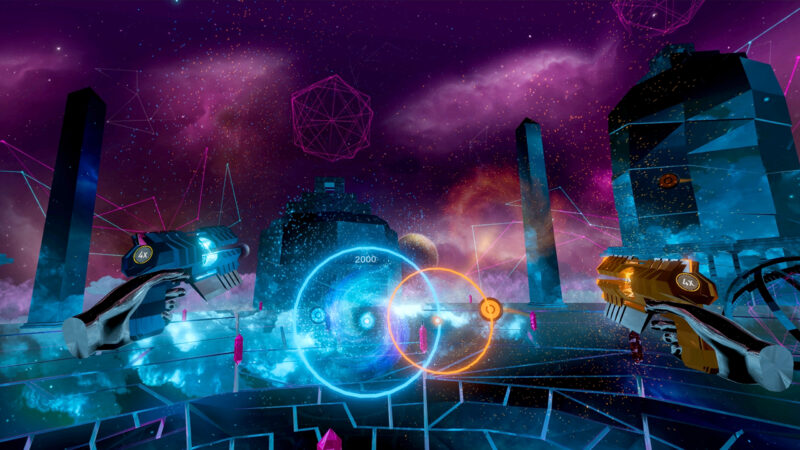
The final element for the visuals and getting the best image for you is IPD, and this is very important with VR. So, I was surprised to see that there was no physical options for setting your IPD and the lenses being stuck in one position. Instead they have gone for software based IPD, which you will find in DPVR Assistant settings. The average for IDP is 64 and mine is 63.8, so I never really got to fully test it for this reason to see how it is handled and how well it works – as I am way to close to the default setting and average of 64.
Taking into account all the hardware and settings mentioned, I really was blown away with how nice, clear and sharp all of the games looked. There was times in games like Half-Life: Alyx, Vertigo 2, Moss and Robinson the Journey I just had to stop and take in how nice it looked in the E4. Also as someone who is a huge fan of visual novels in VR, the clarity really makes a huge difference and I will certainly be checking them all out again using this headset.
AUDIO
The E4 comes with speakers built into the headstap and are placed above your ears, and is very similar to the quality of audio you get with all other headset that use the inbuilt speakers. However, with the E4 I did find the audio sounded tinny compared to others on the market.
DPVR have added a 3.5mm jack into the aforementioned breakout box on the wire coming from the HMD, which hangs behind you about a third of the way down your back. I found with the clip on the wire secured onto your clothes it also stopped the cable from my headphones getting in the way and kept this behind you as well. Which can be very important for those more active games in VR. Given the choice I have always used headphones over inbuilt audio solutions, and personally will find myself doing the same with the E4.
When it comes the microphone, you will get an acceptable and clear quality output, which for me holds a slight improvement over the Meta Quest 2. I have a preferred the use of a wireless microphone in Antlion’s Modmic, which I will continue to use – but, if I didn’t I would be happy using the E4’s microphone to converse in games.
CONTROLLERS
As with the headset upon taking the controls out of the box I was shocked at how light-weight they were and even adding the single AA-battery in each controller, they still feel really light compared to others on the market. Unlike the HMD the plastic did feel more cheap to other controllers, but at no point have I been worried about the overall build quality or feel they will break easily.
At first I was concerned we were going to see the battery consumption of the original Quest and Rift S controllers, as the they seemed to get down to half in a short amount of time. However, since they got to half charge they have not moved any further and I have not had to change them once through all of my testing.
Design-wise the controllers look like the Quest 2 controllers, but the tracking ring is on an angle and the controller surface area is smaller. Even with these changes in mind the controllers are comfortable to use and the spacing between the analogues and buttons is still large enough and comfortable.
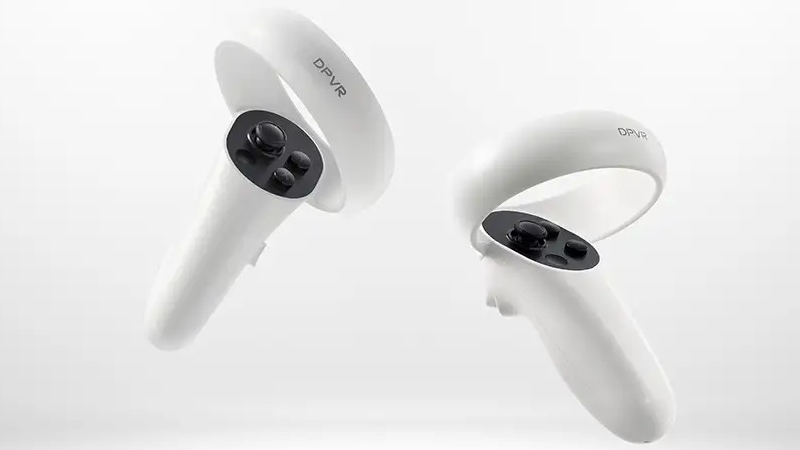
One thing I always worry about is when inside-out-tracking is used, is it can so easily go wrong depending on things like lighting in the room. For this reason I did test the controllers in natural and artificial light and had no issues with the tracking. The only time I found it messed up was when holding the controllers down by my side and slightly back for a prolonged time, but I have the same issues with my Quest 2 and PSVR2 when doing the same thing.
DPVR Assistant comes into play again for your controllers with offering a few settings to help get them working with games. In the settings you can chose standard, analogue or trackpad settings for your controllers. The team at DPVR have provided information within the Assistant on what is the best setting to use for a large number of games. I did find if the game is not listed in the Assistant and the game didn’t work with Standard selected, testing the other settings can make them work.
There was one issue I faced with the controllers and that was the haptics. At times the haptics felt really weak, delayed and in some cases non-responsive, which was a lot more prevalent in the rhythm games I tested them with – this can be an issue as the haptics play an important part in those titles. I did reach out the team at DPVR about this and they have informed that it is with the technical team and they will continue to work on optimising these, so, hopefully this can be sorted with a firmware update for the controllers further down the line.
Additional Testing
With my experience with PCVR already, there was a number of checks I wanted to do outside of what is officially supported on the DPVR FAQ’s. These were launching games via ReVive and Viveport.
With ReVive I was able to launch the supported Oculus PC Store games that will ReVive successfully via the software. However, as mentioned this is not officially supported or promoted by DPVR as something that will work, and performance per-game will vary. But, in most cases I managed to get smooth performance – and Lone Echo without any compression on the DPVR display was beautiful.
It was similar with Viveport, but as Viveport uses Steam VR to launch it’s games I expected this to work as smoothly as it does.
REVIEWED USING DPVR E4
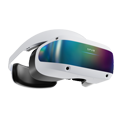
For the purposes of transparency, this review was created using a review product provided by the company or their respective PR company. The use of a review product does not affect my judgement of the product.
REVIEW OVERVIEW

The team at DPVR took an interesting decision to make a wired headset made with PCVR and Steam VR in mind, which is outside the norm for what is happening in 2023. Not only this they wanted to make an affordable headset with specifications which seemed too good for the cost of the device, but to my surprise they have managed to do so. With the decision to use a Display Port over USB-C, really allowing the image to have much more clarity all while offering the same or better specifications of the Meta Quest 2 for a similar cost.
Where it’s not perfect, I do not think any hardware is yet to be perfect and they all come with issues , that others might not have. If you are looking for a headset that is made with PCVR in mind, has great specs, affordable and easy to set-up and get going in VR, the E4 is worth considering.
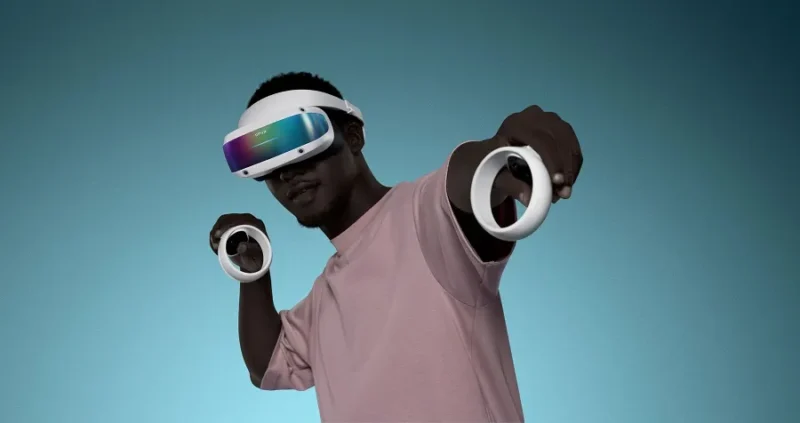
PRODUCT DETAILS
Available to order now
Manufacturer: DPVR
Price: US $549.00
Join the DPVR Discord

